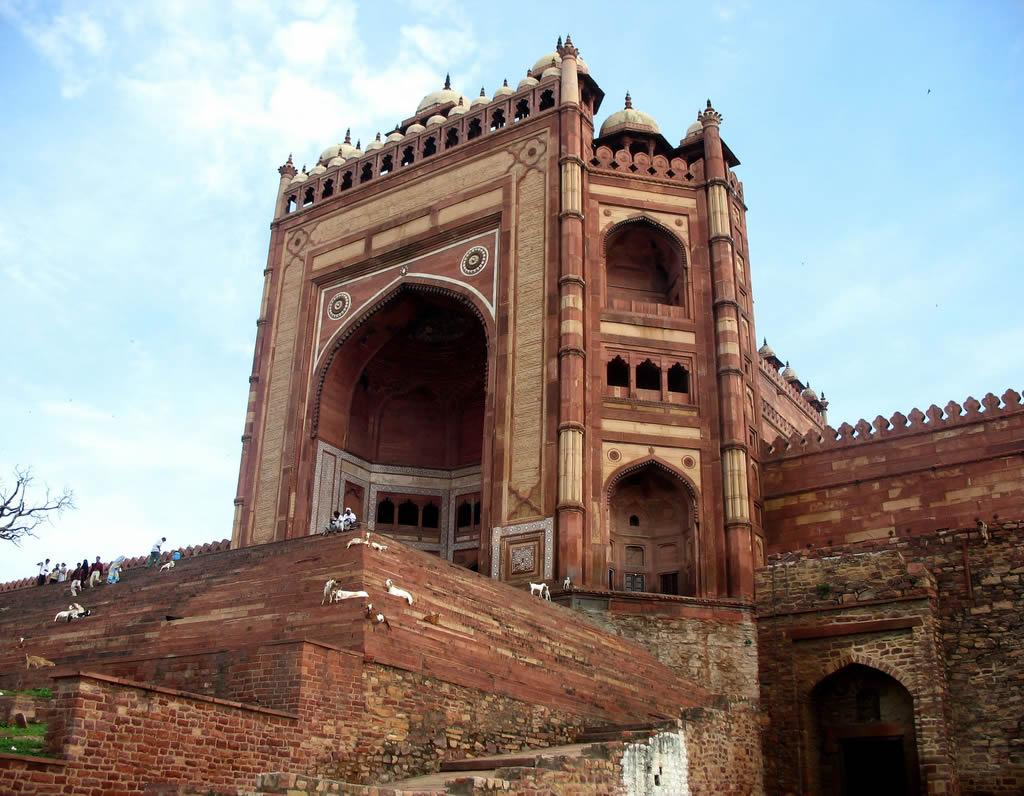
Emperor Akbar’s own interest in the construction of Fatehpur was so all-consuming that he even quarried stone himself, alongside the workmen, as the chronicles of Father Monserrate, the Jesuit Priest recorded during his visit to the city in 1580. A city so brilliantly conceived and actualized, was however, abandoned just after 14 years.
This magnificent fortified medieval city, 40km west of Agra, was the short-lived capital of the Mughal Empire between 1571 and 1585, during the reign of Emperor Akbar. The emperor visited the village of Sikri to consult the Sufi saint Shaikh Salim Chishti, who predicted the birth of not one, but three sons. As the prophecy came true, Akbar built his new capital here, in the village of Salim Chisti, including a stunning mosque – still in use – and three palaces for each of his favourite wives. This enigma was an Indo-Islamic masterpiece, but erected in an area that supposedly suffered from water shortages and thus, was abandoned shortly after Akbar’s death.
It’s easy to visit this World Heritage Site as a day trip from Agra, but there are a couple of decent places to stay, and the colourful bazaar in the village of Fatehpur, just below the ruins, as well as the small village of Sikri, a few kilometres north, are worth exploring. The red-sandstone palace walls are at their most atmospheric and photogenic at sunset.
The bus stand is at the eastern end of the bazaar. Walking another 1km northeast will bring you to Agra Gate and the junction with the main Agra–Jaipur road, from where you can avail the transit facilities.
This red sandstone grandeur was the first planned city in Indo-Islamic style.
An insight
The most celebrated Mughal emperor built the city in the honour of famous Sufi saint Salim Chisti. Located at a distance of around 40km from Agra, it is a medieval Indian city in Uttar Pradesh. Akbar built the city at the end of the 16th century and shifted the capital of the Mughal Empire from Agra to Fatehpur Sikri. The city was later inhabited by the Mughal rulers but for 14 years, before it was secluded was left secluded.
The city is perched atop a rocky ridge and there are wonderful constructions of similar designs across the city. Most of the buildings have similarity in their architectural style. The city is guarded by walls on three sides, and there are seven gates.
Most of the important constructions of the city are seen to the north of the main road leading to Agra from Gaza. They form a homogenous group with influence of Hindu, Persian and Indo-Muslim traditions that can be traced in their architectural inlay.
Amongst some of the important places in the palace are Diwan-i-Am, the Hall of Public Audience, is enclosed by quite a few porticos, where imperial boxes was inserted. Here Akbar along with his ministers used to listen to the problems and complains of his subjects and used to deliver justice.
This imperial box is directly connected to Daulat Khana or Imperial Palace. To the north of this royal edifice, Diwan-i-Kas (Hall of Private Audience) is located. This monument is known mainly for its wonderful central plan which is comprized of a beautiful centre surrounded by a circular balcony: the 'throne'.
Other significant monuments in Fatehpur Sikri are the Ranch Mahal, whose height of four recessed storeies resembles a few Buddhist temples, the pavilion of Turkish Sultana or Anup Talao, the palace of Jodha Bai, the abode of Birbal, problematic 'stables' and the caravanserai.
As you will walk the vast emptiness of Fatehpur, the weary air hanging over will clinch to your senses that when Akbar and his court moved to Lahore from Fatehpur in 1585, it was not just the royal family, in fact, the Emperor took the life from Sikri leaving a vast ghostly city, Fatehpur Sikri.
Are you interested to know more about the spirit of the city of Fatehpur?
Let us hear from you at +91 33 4046 4646.
As suggested and to be customized as per request

 Loading..
Loading..